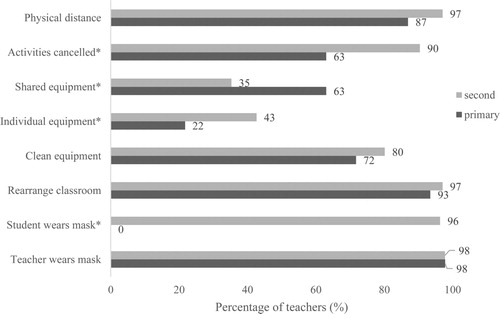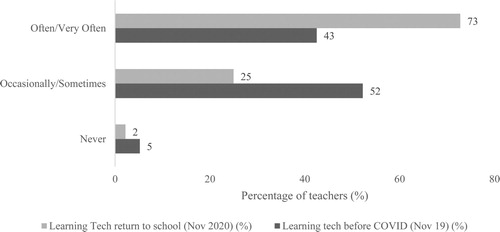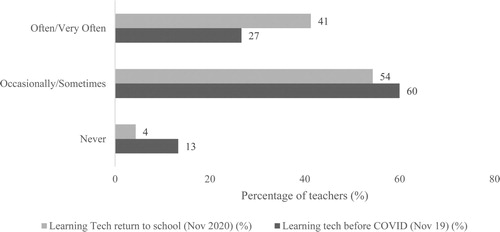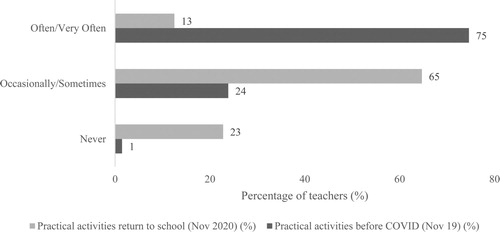Abstract
In September 2020, Irish schools reopened following their emergency closure due to the COVID-19 crisis. Measures were put in place to minimise the risk of transmission of the virus within schools and communities. However, these measures were likely to impact on teachers’ capacity to facilitate learning in science, particularly the practical and investigative aspects of the Irish curriculum. This research explores the impact of the measures in place to limit virus transmission on teaching and learning in science, particularly on practical activities. The period of focus is the three months (September to November 2020) following the school closures. The research aims to highlight the implications of the COVID-19 crisis on science teaching and learning in Irish schools. The research will also provide recommendations to lessen the impact on primary and second-level science education to improve student learning and engagement in science.
Keywords:
Research background and rationale
In September 2020, Irish schools reopened for the first time following four months of closure (March to June 2020) due to the COVID-19 crisis. When schools reopened, measures were put in place to minimise virus transmission within schools and communities (WHO Citation2020). These measures included physical distancing, wearing of masks (adults and children over 12), hand hygiene and respiratory etiquette, frequent cleaning of equipment and teaching aids, and spacing of desks or grouping of children (WHO Citation2020). In Ireland, national guidance for primary schools recommended that students maintained a one metre physical distance from each other but the use of ‘pods’ allowed students to work in small groups using shared equipment. Primary teachers were advised to prioritise wellbeing, literacy and numeracy within their teaching of the curriculum (DES Citation2020a). At second-level, recommended measures included physical distancing, avoiding and minimising students sharing equipment, and sanitising equipment between use (DES Citation2020b).
Methodology and theoretical perspective
Research indicates that lack of adequate funding to provide appropriate learning spaces and sufficient availability of equipment are key factors in supporting learning in practical subjects in Irish schools (Kennedy Citation2014). Therefore, measures that impact the use of science learning spaces, such as physical distancing and rearranging desks, along with the need to provide equipment and resources for use by individual students are likely to impact on teachers’ capacity to facilitate science learning. This impact is particularly significant for achieving the practical and investigative aspects of the Irish science curriculum (Government of Ireland Citation1999; NCCA Citation2015). In addition, research indicates the negative impact of the COVID-19 school closures on student learning in science during March to June 2020 and a decrease in facilitation of practical activities during this time (Chadwick and McLoughlin Citation2020). As a consequence, teachers may have felt under pressure to catch-up on missed learning opportunities and practical work in science upon return to school (ASE Citation2020).
This research explores the impact of measures put in place in Irish science classrooms to limit virus transmission, during the months of September to November 2020. The research examines: What impact did the measures put in place to limit virus transmission have on teaching and learning in science, in Irish primary and second-level schools?
Primary and second-level teachers of science were invited to participate in an online survey distributed via social media networks and directly to school email addresses. The survey was adapted from a previously published national survey instrument (Chadwick and McLoughlin Citation2020). The survey collected responses over a two-month period, December 2020 to January 2021, and collected responses from 182 teachers, including 46 primary and 136 second-level teachers ().
Table 1. Number of participating teachers by years of experience and education levels.
Section one of the survey gathered information relating to the teacher’s qualifications and number of years of teaching experience. Section two requested teachers to identify the measures put in place in their science learning spaces from a list of options. Section three asked teachers to rate the impact of the measures on their capacity to carry out aspects of teaching, learning and assessment, using a five-point semantic differential scale. Section four asked teachers to state the frequency of their use of learning technologies (e.g. Email, Zoom, Seesaw, Aladdin, Google Apps/Classroom, private social media) in November 2019 and November 2020, using a five-point Likert scale. Similarly, section five asked teachers to rate the frequency of facilitation of practical activities. Quantitative analysis of these sections involved comparison of responses of different groups (primary or second-level teachers/number of years of experience) using non-parametric comparison of medians (Mann Whitney U test) in SPSS. The frequency of use of learning technologies and facilitation of practical activities (November 2019 and November 2020) were compared using the non-parametric, Wilcoxon signed-ranks test in SPSS.
Open response questions asked teachers to provide details of any ‘catch-up supports’ put in place during September to November 2020. Qualitative coding of responses was conducted using NVIVO software (Schreier Citation2012).
Findings and results
Teachers identified the measures in place in their science classes to limit virus transmission, as shown in . There was a significant difference between primary and second-level teachers' responses to questions relating to the use of individual and shared equipment, and cancellation of practical activities.
In terms of physical distancing, most teachers reported physical distancing to be at least one metre (95%), and 8% of these teachers reported two metre physical distancing. Nearly all teachers (98%) stated that they wore a mask to teach and that they had rearranged the classroom layout (93%). Most teachers stated that they cleaned equipment between uses (72%). Nearly all second-level teachers stated that their students wore masks (96%), while mask wearing was not mandatory for primary school students (DES Citation2020a). The majority of second-level teachers (90%) cancelled some science activities, compared to 63% of primary teachers. In terms of measures in place relating to shared and individual equipment, over half of primary teachers (63%) permitted sharing science equipment within a group, while only around one-third (35%) of second-level teachers allowed this. Less than half (43%) of second-level teachers facilitated individual use of equipment, compared to less than one quarter (22%) of primary teachers. This finding highlights a need to provide adequate funding support for equipment in both primary and secondary level to enable individual use in science lessons.
The majority of teachers reported a negative impact of measures in place to limit virus transmission, on five aspects of teaching, learning and assessment in science, as outlined in . Almost all teachers (94%) stated that the measures in place had a negative impact on their capacity to facilitate practical activities in science. Over three quarters of teachers (78%) reported a negative impact on their capacity to support student learning generally. There was no significant difference between primary and second-level teachers, or between teachers with less than or more than five years of experience, using non-parametric comparison of medians (Mann Whitney U test) for these five aspects.
Table 2. Impact of measures on five aspects of teaching and learning in science (all teachers).
Frequency of use of learning technologies
The Wilcoxon signed ranks test showed a significant increase in the use of learning technologies in November 2020 compared to November 2019 (prior to the COVID-19 crisis) among both primary (p=0.048) and second-level teachers (p<0.001). However, there were significant differences between primary and second-level teachers’ use of learning technologies, using non-parametric comparison of medians (Mann Whitney U test). Nearly three quarters (73%) of second-level teachers reported the use of learning technologies for most or every lesson (often/very often) (), while less than half (41%) of primary teachers reported using learning technologies this frequently () during November 2020. This finding highlights an urgent need to increase investment in learning technologies in Irish education.
There was no significant difference between teachers with less than or more than five years of experience using non-parametric comparison of medians (Mann Whitney U test).
Frequency of facilitation of practical activities
The Wilcoxon signed ranks test showed a significant decrease in the frequency of facilitation of practical activities in November 2020 compared to November 2019 among primary (p< .01) and second-level (p< .001) teachers. However, there was a significant difference between primary and second-level teachers’ facilitation of practical activities, using non-parametric comparison of medians (Mann Whitney U test). Nearly one quarter (23%) of second-level teachers reported never facilitating practical activities () while only 15% of primary teachers reported never facilitating practical activities ().
There was no significant difference between teachers with less than or more than five years of experience using non-parametric comparison of medians (Mann Whitney U test).
Catch-up supports provided
The categories identified through qualitative coding and the proportion of references coded into each category is shown in . Catch-up supports provided by primary teachers focused mainly on changes to the timetable, pace and focus of lessons and home-based learning using ICT. Second-level teachers described catch-up supports mostly provided through home-based learning using ICT and revision tests and quizzes.
Table 3. Catch-up supports identified through qualitative coding.
Discussion and conclusion, including future-facing recommendations
In Ireland, schools reopened in September 2020 after four months of closure due to the COVID-19 crisis. In this study, primary and second-level teachers identified a range of measures put in place in their science learning spaces to limit virus transmission. Findings highlight that these measures had a negative impact on teaching, learning and assessment in science. Most strikingly, over 90% of teachers stated the negative impact of these measures on their capacity to facilitate practical activities. Whereas prior to the COVID-19 crisis, over half of primary teachers facilitated practical activities most or every lesson, only one fifth did so whilst virus transmission measures were in place. The decrease in facilitation of practical activities was significantly more severe at second-level. Prior to the COVID-19 crisis, three quarters of second-level science teachers facilitated practical activities most or every lesson and this decreased to one in eight teachers during November 2020. These changes in practices can be linked to the specific measures put in place in primary and second-level schools. While the majority of primary and second-level teachers reported they did not facilitate the individual use of equipment, in primary science classes sharing of equipment in small groups (pods) was generally permitted as per government guidelines (DES Citation2020a). The lack of availability of science equipment for individual use and government guidelines on the practice of sharing equipment (DES Citation2020b) may be a contributing factor in the stark decrease in the facilitation of practical activities during this period. Practical activities in science are a mandatory aspect of the Irish science curriculum and they are known to promote skills development and positive attitudes towards science (Irish Government Citation1999; Kennedy Citation2014; NCCA Citation2015). This study highlights the need for adequate funding to support the facilitation of practical activities in Irish primary and second-level schools in line with government guidelines during the COVID-19 crisis.
Technology supported, remote learning can be beneficial for fostering increased connectedness between school and home learning (Marcus-Quinn, Hourigan, and McCoy Citation2019). However, in the context of emergency remote learning during the COVID-19 crisis school closures, immediately prior to the focus of this study, students reported increased stress, more individual work, and less collaboration with their peers (Bray et al. Citation2020). During the reopening of schools, this study shows that three quarters of second-level teachers used learning technologies to support science learning in most or every lesson. Second-level teachers also described how they used learning technologies to provide materials and communicate with and support students to catch-up on missed learning opportunities due to previous school closures.
Primary teachers are required to teach a broad range of curricular subjects, and balance time spent on investigative activities in science with other priorities such as literacy and numeracy (DES Citation2020a; Government of Ireland Citation1999; Murphy, Neil, and Beggs Citation2007). Primary teachers in this study described how they adapted their curricular planning, in terms of adjustments to timetable, schedule and pace. Teachers described prioritising literacy, numeracy and wellbeing, over science, as per government guidelines (DES Citation2020a). This is likely to have been compounded by the measures in place to limit virus transmission, resulting in the negative impact on learning and decrease in science practical activities during September to November 2020.
Implications and recommendations
Research into the impact of the COVID-19 crisis on education is critical in enabling policymakers to make evidence-based decisions regarding education policies and practices in the context of the COVID-19 pandemic. Understanding the implications of measures to limit virus transmission, as outlined in this study, allows educators and educational policy makers to plan appropriate educational support, funding and professional development. This study highlights that a major barrier to facilitation of practical activities for primary and second-level teachers of science was the lack of science equipment available for individual practical work. This issue needs to be urgently addressed at national level.
One of the positive impacts observed during the COVID-19 crisis has been the increased use of learning technologies (e.g. Email, Zoom, Seesaw, Aladdin, Google Apps/Classroom, private social media) by Irish science teachers, particularly at second-level. The benefits of the use of learning technologies to support differentiated learning and assessment should be strongly considered and inform future investment in educational technologies for primary and second-level science education (Marcus-Quinn, Hourigan, and McCoy Citation2019). Further investment and infrastructure to support the use of learning technologies may help to mitigate the negative impact of the COVID-19 crisis on practical subjects such as science. In addition, this study highlights the need to provide continual professional learning opportunities for primary and second-level teachers to increase their confidence and competence in the use of learning technologies in science education.
Dramatic changes in Irish schools during 2020, including the rapid switch to remote learning during emergency school closures (ASE Citation2020) and strict virus transmission control measures during the reopening of schools, have had a significant impact on science teaching and learning practices in Irish schools. This study highlights an urgent need to increase investment in Irish schools and provide adequate resources, such as science equipment and learning technologies, to enable teachers to facilitate practical activities in science while adhering to strict safety measures.
Supporting teachers to continue teaching, remotely and in-person, throughout the COVID-19 crisis is considered a priority for the education and wellbeing of the nation’s children and young people (OECD Citation2021).
Ethical considerations
This study received ethical approval from the Research Ethics Committee at the authors’ institution for this low-risk study. All teachers gave consent to participate.
Disclosure statement
No potential conflict of interest was reported by the author(s).
Additional information
Notes on contributors
Ruth Chadwick
Ruth Chadwick is a post-doctoral researcher and lecturer in Initial Teacher Education with Centre for the Advancement of STEM Teaching and Learning (CASTeL) and the School of Physical Sciences at Dublin City University. She completed a Ph.D. in 2018 entitled ‘Development and Assessment of Scientific Literacy for Secondary Level Science Education’. The focus of this research was on curricular policy development and assessment in the science curricula of Scotland and Ireland. She completed her undergraduate degree in Zoology and subsequently obtained a PGCE in secondary education in science and biology. She worked for five years as a secondary school teacher in Scotland, during the introduction of the Curriculum for Excellence. From this she gained an insight into curricular policy development from the ‘chalk-face’.
Eilish McLoughlin
Eilish McLoughlin is an Associate Professor in the School of Physical Sciences and Director of the Research Centre for the Advancement of STEM Teaching and Learning (CASTeL) at Dublin City University. She obtained her Ph.D. in Experimental Surface Physics. Her interests focus on physics and science education research. She has led and collaborated in over 50 research projects at EU, national, and local levels that examine the development of curriculum, instruction and assessment models that target integrated STEM and inquiry approaches, at all levels of education, from primary school to Ph.D. level.
References
- ASE (Association for Science Education). 2020. Good Practical Science – making it Happen Post-Covid 19. Report on an Extensive Survey of Science Educators, Investigating New Opportunities and Challenges for Secondary Schools and Colleges. England: ASE.
- Bray, A., E. Ní Chorcora, J. Maguire Donohue, J. Banks, and A. Devitt. 2020. Post-primary Student Perspectives on Teaching and Learning During Covid-19 School Closures: Lessons Learned from Irish Students from Schools in a Widening Participation Programme. Ireland: Trinity College Dublin.
- Chadwick, R., and E. McLoughlin. 2020. Impact of the COVID-19 Crisis on Science Teaching and Facilitation of Practical Activities in Irish Schools. Online: EdArXiv. https://doi.org/10.35542/osf.io/vzufk.
- DES. 2020b. Return to School Guidance for Practical Subjects in Post-Primary Schools and Centres for Education. Ireland: Government of Ireland. https://www.gov.ie/en/publication/7acad-reopening-our-post-primary-schools/.
- DES (Department of Education and Skills). 2020a. Control Measures: COVID-19 Response Plan for Safe Reopening of Primary Schools. Ireland: Government of Ireland. https://www.gov.ie/en/publication/a0bff-reopening-our-primary-and-special-schools/.
- Government of Ireland. 1999. Science: Social, Environmental and Scientific Education. Ireland: Government of Ireland.
- Kennedy, D. 2014. “The Role of Investigations in Promoting Inquiry-Based Science Education in Ireland.” Science Education International 24 (3): 282–305.
- Marcus-Quinn, A., T. Hourigan, and S. McCoy. 2019. “The Digital Learning Movement: How Should Irish Schools Respond?” The Economic and Social Review 50 (4): 767–783.
- Murphy, C., P. Neil, and J. Beggs. 2007. “Primary Science Teacher Confidence Revisited: ten Years on.” Educational Research 49 (4): 415–430.
- National Council for Curriculum and Assessment. 2015. Junior Cycle Science: Curriculum Specification. Ireland: NCCA.
- OECD. 2021. Positive, High-Achieving Students?: What Schools and Teachers Can Do. France: TALIS, OECD Publishing. https://doi.org/10.1787/3b9551db-en.
- Schreier, M. 2012. Qualitative Content Analysis in Practice. UK: Sage Publications.
- WHO (World Health Organization). 2020. Considerations for School-Related Public Health Measures in the Context of COVID-19: Annex to Considerations in Adjusting Public Health and Social Measures in the Context of COVID-19. Switzerland: WHO.





